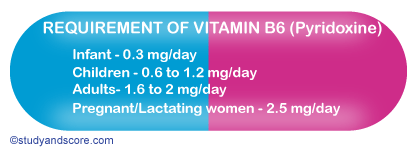In 1934, Paul György discovered vitamin B6 while conducting research on skin diseases associated with rats. Later in 1939 this vitamin was named pyridoxine.
Pyridoxine is necessary to use the energy obtained from the food, in RBC production and in correct functioning of nerves. Pyridoxine can prevent vitamin B6 deficiency resulting from insufficient and non nutritious diet. Moreover some medications and medical conditions aso lead to vitamin B6 deficiency. Pyridoxine is 3-hydroxy 4, 5 dihydroxy methyl 2- methyl pyridine. Pyridoxal phosphate is the metabolically active form of vitamin B6.
Meat especially organ meats, whole grain cereals, peanuts and wheat germ are rich sources. Milk and green vegetables supply smaller amounts.

Although most of the body’s vitamin B6 is associated with glycogen phosphorylase in muscle, this is relatively stable and well conserved. The requirement of Vitamin B6 completely depends on the amount of energy utilized by the body and metabolism of glycogen. Also intake of protei has some significance.

Small intestine readily absorbs pyridoxine.Though pyridoxine is ingested in excess it is excreted out in urine and is not stored by the body.
Deficiency of vitamin B6 is extremely rare. Nervous disturbances such as irritability, insomnia, muscular weakness, fatigue and convulsion have been recorded in infants with vitamin B6 deficiency. The cause of the convulsions is severe impairment of the activity of the enzyme glutamate decarboxylase, which is dependent on pyridoxal phosphate.
The product of glutamate decarboxylase is GABA (γ-aminobutyric acid) which is a regulatory neurotransmitter in the central nervous system.
In nature three forms of vitamin B6 exist namely pyridoxamine, pyridoxine and pyridoxal . The functions of vitamin B6 are closely related to protein metabolism,
- Share with your friends! -
Login to post your comment here...
- or with social Account -